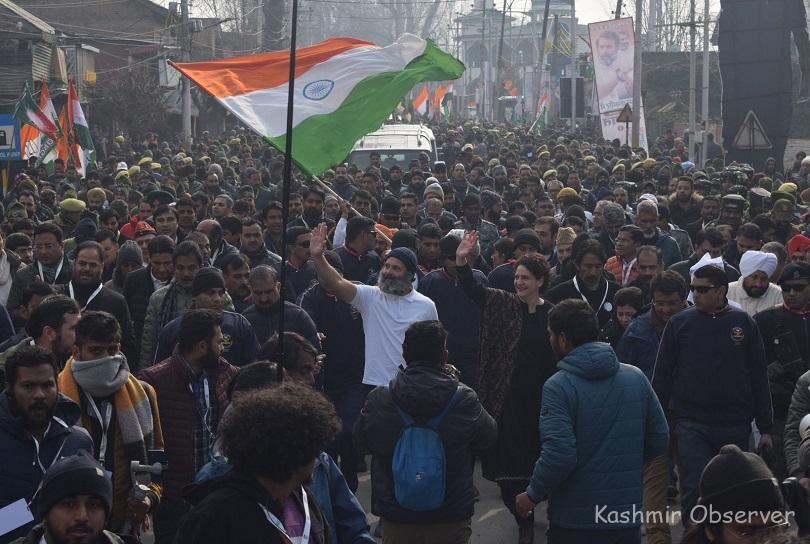(MENAFN- Kashmir Observer) KO Photo by Abid Bhat
It has certainly generated some goodwill for Congress, and things look potentially set for a change. But Modi persona still looms large
RAHUL Gandhi had an enormous popular reception in Jammu and Kashmir, which was not entirely unexpected. More so in Kashmir Valley, where the participation in the yatra was the first such major political mobilization of people after the withdrawal of Article 370 in August 2019. Major Kashmiri mainstream leaders, who now generally refrain from holding public rallies, seized the opportunity to walk alongside Gandhi. But the yatra, the first and foremost, was about Gandhi, his alternative idea of India, and Kashmiri leaders were making a symbolic statement by participating in it.
In Kashmir, the yatra transcended political or electoral calculations. For one, many people who took part in it in the Valley – or for that matter in parts of Jammu – didn't do so out of a sense of allegiance to Congress. It became a pretext to assert themselves in disguise – a way to mobilize in the face of the shrinking space for doing so over the last few years. So, while the yatra may do little to revive Congress in the union territory in the near future, it has provided a channel to vent some pent-up frustrations in Kashmir and in Jammu too – but for largely divergent reasons.
However, the participation in Gandhi's yatra also reflected a transformed political context in Kashmir. Here was a top national leader coming to Lal Chowk to hoist the national flag and many Kashmiris were ready to welcome it – and the rest didn't seem to mind it. Have the terms of political discourse now irrevocably changed in Kashmir? Well, as things stand, they seem to have. Aside from the participation of individuals, the yatra has thus brought to light the current political realities in Kashmir.
But these realities are not immediately relevant to the yatra, whose aim is to combat the BJP's ideological vision for India and, in the process revive Congress. At the yatra's conclusion in Lal Chowk, it is difficult to imagine whether it has or may in the near term achieve any of those goals. But it certainly has introduced a new dynamic and seeded the ground with new political possibility. When and how it would play out in the coming weeks and months remains to be seen.
But there are some distinct takeaways that can't be ignored. In Kashmir, the yatra did generate some political buzz. For one, it has reinvigorated the Congress' rank and file in the union territory boosted further by the return of leaders who had joined the former Congress leader Ghulam Nabi Azad's newly floated Democratic Azad Party. And for another, Congress entered the former state with a proper political agenda: it sought statehood and Article 371 for J&K. The demand is likely to find a wider political resonance in the UT, including in the Jammu division, where people have become insecure about losing lands and jobs to outsiders.
But more than J&K, the yatra has political significance for the party at the national level. It seems to have breathed a new life into an otherwise dying party. Gandhi drew reasonably good crowds. But mobilizing crowds doesn't guarantee a good electoral performance as was clear in the last Assembly polls in Gujarat and Himachal Pradesh, where Congress performed miserably in the former state, there will be more tests ahead. Around ten Assembly elections are scheduled to be held before the national elections. Among them, the elections in Karnataka, Chhattisgarh, Madhya Pradesh, Rajasthan and Telengana will be very crucial. The BJP will hope to win all of them. But should the party suffer reverses in the majority of these states, this may not bode well for its 2024 chances. The elections in these five major states represent the last chance for the opposition, especially the Congress, to hurtle back into the reckoning. For now, the party can take heart from the victory in Himachal. It can put some wind in its sails as it prepares for the upcoming Assembly elections.
As for Gandhi's makeover, many political observers remain skeptical about his ability to generate a public groundswell in favour of the Congress. Some are calling the yatra the umpteenth“relaunch” of Gandhi who has so far singularly failed to match up to the political persona of prime minister Narendra Modi. Will he pull it off this time around? The odds are heavily against it. Ever since he took over the leadership of the Congress, both in his formal and de facto roles, Gandhi has proved incapable of rallying people behind the party. True, PM Modi's charisma, oratory skills, and media support have made Hindutva a reigning ideology of the country, but the lack of an alternative ideological narrative has made the BJP's job even easier.
The absence of a narrative, however, is not the only undoing of the Congress. The organization has itself been falling apart with Gandhis becoming its principal political liability, something that may now be changing.
Will the tide turn now? It is difficult to tell. The yatra has certainly generated some goodwill, and things look potentially set for a change. Congress has finally shown some assertiveness about pursuing an inclusive political agenda, but a proper ideological narrative is far from taking shape.
Views expressed in the article are the author's own and do not necessarily represent the editorial stance of Kashmir Observer
follow this link to join our whatsapp group : join now
























Comments
No comment